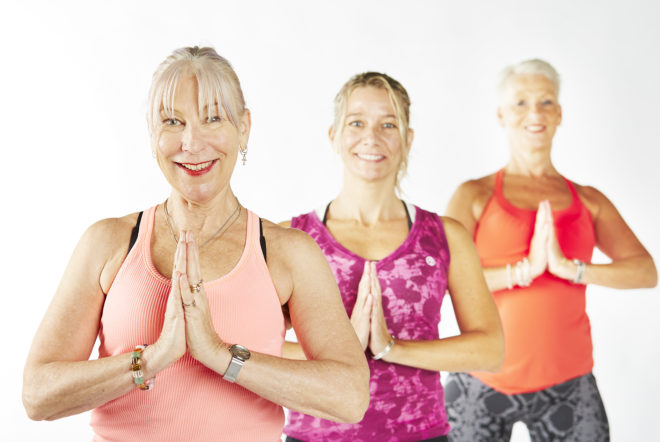The beginnings of Yoga were developed by the Indus-Sarasvati civilization in Northern India over 5,000 years ago. The word yoga was first mentioned in the oldest sacred texts, the Rig Veda.
The Vedas were a collection of texts containing songs, mantras and rituals to be used by Brahmans, the Vedic priests.
Yoga was slowly refined and developed by the Brahmans and Rishis (mystic seers) who documented their practices and beliefs in the Upanishads, a huge work containing over 200 scriptures.
The most renowned of the Yogic scriptures is the Bhagavad-Gîtâ, composed around 500 B.C.E.
The Upanishads took the idea of ritual sacrifice from the Vedas and internalized it, teaching the sacrifice of the ego through self-knowledge, action (karma yoga) and wisdom (jnana yoga).
The physical Asanas or poses are actually only one limb of eight that makes up the tradition of Yoga.
In India the Yoga Asanas were only a physical tool used to keep the body (and therefore mind) flexible to enable the yogis to sit for long periods of time in meditation.
Allowing them to abide in the healing prana (or chi/energy) in the breath, helping to open and expand the mind into greater realities and dimensions.
Through the vigilant practise of yoga; combining movement, breath, concentration and stilling or quieting down the mind, the yogi moves steadily towards the state of Samadhi or bliss which is the 8th Limb of Yoga.
Asana Is The 3rd Limb Of The 8 Limbs Of Yoga
The Following Is A List Of 10 Different Yoga Styles Practicing Asanas (Poses).
There are more styles evolving as Yoga becomes a modern practice for the 21st Century Lifestyle.
Hatha
Hatha yoga is a generic term that refers to any type of yoga that teaches physical postures. Nearly every type of yoga class taught in the West is hatha yoga.
When a class is marketed as hatha, it generally means that you will get a gentle introduction to the most basic yoga postures.
You probably won’t work up a sweat in a hatha yoga class, but you should end up leaving class feeling longer, looser, and more relaxed.
Ashtanga
Ashtanga is based on ancient yoga teachings, but it was popularized and brought to the West by Pattabhi Jois (pronounced “pah-tah-bee joyce”) in the 1970’s.
It’s a rigorous style of yoga that follows a specific sequence of postures and is similar to vinyasa yoga, as each style links every movement to a breath. The series can be customized to suit any body type at any level.
Classes move at a rigorous pace with “vinyasas” (plank-chaturanga-up dog-down dog transitions) between poses and plenty of hands-on attention from the teacher.
There is no music and each pose is held for three to five breaths, and classes last 75-90 minutes, though a beginner class is often shorter. Props are not traditionally used, but many teachers will allow them.
The difference is that ashtanga always performs the exact same poses in the exact same order. This is a hot, sweaty, physically demanding practice.
Bikram
This is a new modern Yoga, approximately 30 years old and is very popular in the Western world as it attracts celebrities who maintain that it is an excellent and fast weight loss program.
It is quite controversial in that it is an ego based yoga using mirrors with the best practitioners at the front of the class. Bikram Choudhury developed this school of yoga where classes are held in artificially heated rooms up to 42 deg.
In a Bikram class, you will sweat like you’ve never sweated before as you work your way through a series of 26 poses (like ashtanga, a Bikram class always follows the same sequence, although a Bikram sequence is different from an ashtanga sequence).
Bikram Choudhury has trademarked his sequence and has prosecuted studios who call themselves Bikram but don’t teach the poses exactly the way he says they should.
Avoid these class if you have injuries as the heated room can tend to mask injuries and practitioners often over stretch and damage ligaments and muscles.
Iyengar
This yoga was developed and popularized by B.K.S. Iyengar (pronounced “eye-yen-gar”). Iyengar is a very meticulous style of yoga, with utmost attention paid to finding the proper alignment in a pose. In order to help each student find the proper alignment.
Yoga props, such as blocks, blankets, straps, chairs, bolsters, and a rope wall are all common in an Iyengar class. It is physically and mentally challenging and Iyengar teachers must undergo a comprehensive training.
Iyengar Yoga is wonderful for balancing an injured body due to the precise and guided instruction. It is great for beginners, those recovering from injuries, and anyone with mobility issues. Appropriate for young and old.
Restorative
Restorative Yoga and Pilates is a wonderful way to relax and soothe stressful minds and bodies.
Restorative classes use bolsters, blankets, and blocks to prop students in passive poses so that the body can experience the benefits of a pose without having to exert any effort.
A good restorative class is more rejuvenating than a nap. These classes are offered at the end of a busy week on a Friday evening when rest and recovery is required.
Vinyasa or Flow Yoga
Vinyasa (pronounced “vin-yah-sah”) is the Sanskrit word for “flow”, and vinyasa classes are known for their fluid, movement-intensive practices. Vinyasa teachers choreograph their classes to smoothly transition from pose to pose, and often play music to keep things lively. The intensity of the practice is similar to Ashtanga, but no two vinyasa classes are the same.
Kundalini
This is the practice that concentrates on awakening the energy at the base of the spine and drawing it upward. In addition to postures, a typical class will also include chanting, meditation, and breathing exercises.
Kundalini refers to a coil of dormant energy that rests at the base of the spine. The aim of kundalini yoga is to awaken, harness and release this energy. This branch of yoga is very meditative and spiritual, and moves slowly with a focus on meditation and pranayama (breathing exercises).
Power Yoga
This is the American interpretation of ashtanga yoga, a discipline that combines stretching, strength training, and meditative breathing. But power yoga takes ashtanga one step further.
Many of the poses resemble basic gym based exercises as in push-ups, handstands, toe touches and side bends. The key to Power Yoga is sweat-producing, muscle-building power and pace. Instead of pausing between poses as you would in traditional yoga, each move flows into the next, making it an intense aerobic workout.
Yin Yoga
Also called Taoist yoga, Yin yoga integrates principles of hatha yoga and qi gong, along with other aspects of Taoism. This is sometimes referred to as yoga for the joints, not the muscles, as it directs the stimulation normally created by the asana into areas deeper than the superficial or muscular tissues.
Yin Yoga works the connective tissues of the ligaments, fascia, joints and bones. A significant characteristic is the long held, passive nature of the postures. While initially this style of yoga may seem passive, it can be quite challenging due to the long duration of the postures, lasting from five to twenty minutes.
Yin Yoga is a wonderful Restorative Yoga and is great for Beginners and people who enjoy meditation practice.
Viniyoga
Founded by Krishnamacharya’s son, T.K.V. Desikachar, viniyoga is highly individualized with an emphasis on adapting every pose and every practice to suit a person’s needs and abilities. The practice is often taught one on one and is sometimes referred to as “yoga therapy.”
It is wonderful for people with back injuries, mobility issues or recovering from injuries.
Yoga Nidra (The Waking Sleep)
Developed by Satyananda Saraswati, in the 1960’s is the complete mind and body relaxation that can be done from as little as 5-10 minutes up to an hour, taking the practitioner while lying in Savasana (corpse pose) or sitting comfortably in a chair or floor slowly through the parts of the body by saying each part.
It is done in a state of consciousness between waking and sleeping, like the “going-to-sleep” stage. The yogic goal of both paths, deep relaxation and meditation are the same, a state called Samadhi.
YogaPilates Fusion®
Was developed by Jill Healy-Quintard in 2001, after suffering injuries in a hot Yoga class. She has brought together the Fusion of Breath and the Focus of Yoga Asana with the Core Strength, Balance, Concentration and Flowing Moves of Pilates followed by a 5-10 minute Yoga Nidra Meditation (The Waking Sleep) for a complete mind/body balance.
The word Yoga means “to join or yoke together,” and it brings the body and mind together into one harmonious experience.
Although it began many years ago in India Yoga did not arrive in the Western world until the late 1800’s.
Yoga did not become widely known until the 1960’s, when it became part of the youth culture’s growing interest in enlightenment and anything Eastern.
As more has become known about the beneficial effects of Yoga, it has gained acceptance and respect as a valuable method for helping in the management of stress and improving health and well-being and the evolvement of a fusion of practices has become very much part of the ‘new generation’ of what is known as Yoga in the Western World.
The exchange of Namaste at the end of class is a wonderful way to honour the true self in each of us, and recognize that all life is interrelated. ©Body and Balance: Jill Healy-Quintard
You can find much more information on living a holistic lifestyle in these free magazines and on our YouTube channel.
Jill Healy-Quintard – Yoga Teacher
REFERENCES:
*Dynamic Yoga: by Godfrey Devereux
http://yoga.about.com/
www.yogabasics.com/learn/history-of-yoga/








Wonderfully educational piece. Thank you very much for writing. Absolutely loved it. I’ll save it in my records. Working on a new book for friends and family and this was very enlightening.
So glad you enjoyed reading our articles.